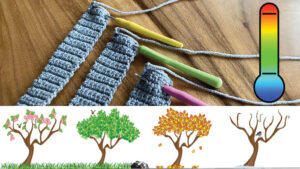
Have you actually completed 365 rows of crochet? It's way too long with the recommended hook size to the yarn. I have figured out some solutions for temperature blankets.
Using Red Heart Super Saver as an option. The label says 5.5 mm / I Hook. Doing single crochet for the year, the blanket will be approx 102" long which is 8.5 feet. If you are not paying attention to gauge it could end up to 120" which is 10 feet cool to look at but not practical.
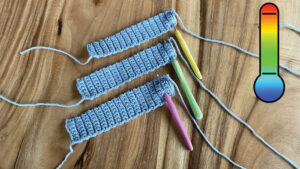
Hook Changes
I decided to try a gauge check by changing the hooks with keeping Red Heart Super Saver as a constant. How low can I go before it gets impossible to crochet with the hook size.
- Size F, 3.5 mm Hook, full-year is 90" long which is 7.5 feet. Each month is approx 7.5"
- Size D, 3.125 mm Hook, full-year is 84" long which is 7 feet. Each month is approx 7".
- Size C, 2.5 mm Hook, full-year is 78" long which is 6.5 feet. Each month is about 6.5".
For me personally, Size C would be the best for my throw on the sofa while watching tv. If I really wanted to have a snooze, Size D would be my next choice.
How A Temperature Afghan Works

Can either check your temperature outside of your home or refer to the Weather Network each day and crochet accordingly. If you think you are not going to crochet for a day, just take the temperature and write it down so when you pick up your project, you have that information handy. I would personally collect temperatures and then binge crochet as some days, the colour may not change at all.
The temperature gauge is showing 6 colours of Caron One Pound yarn.
Once you know the temperature, look at your gauge and crochet the colour that falls within the temperature readings.
The trick is not to cheat the system by falsifying a temperature because you think the colour shouldn't go where it does. The whole point is capturing the temperature as it happens to make the afghan a true representation of the season you are crocheting in.
PSST... if you cannot start on the first of the month, you can start anytime, when you are done, no one is really going to know if you started on the 1st of the month or had to delay it.
Just for Fun
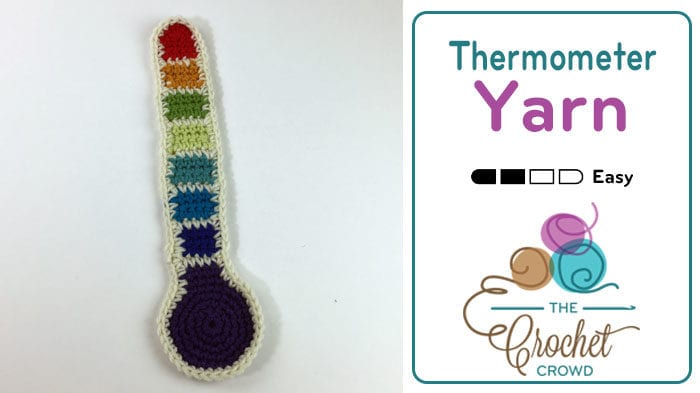
The Yarn Thermometer is complimentary to your Temperature Afghan. You can apply this thermometer to your project when complete so people have an idea of what the colours mean. The colours used in the thermometer are subjective to whatever you decide is appropriate.
For us here in the North, our temperatures can range from - 20 to over 40 degrees in the summer. We have a wide range of temperatures. If you live in a warmer climate, you may have different increments so you have a variety of colours.
Instructions
Use as many colours as you feel you want in your Temperature Afghans or projects. Using the coldest colour, start with the ball area of the base of the thermometer.
- (RS) Using the coldest colour. Ch 2, 6 sc second ch from hook. Join with sl st to first sc.
- Ch 1, 2 sc in each st around. Join with sl st to beg sc.
- Ch 1, *1 sc, 2 sc in next. Repeat * around. Join with sl st to beg sc.
- Ch 1, *1 sc in next 2 sts, 2 sc in next. Repeat * around. Join with sl st to beg sc.
- Ch 1, *1 sc in next 3 sts, 2 sc in next. Repeat * around. Join with sl st to beg sc.
- Ch 1, 1 sc in next 5 sts. Turn.
- Ch 1, 1 sc in each across. Fasten off colour.
Separation Colour - Cream / White (subjective to your creativity)
- Attach separation colour, ch 1, 1 sc in each across. Fasten off.
With the next colours all the way to the colour before the top colour. Do as follows.
- Attach the next colour. Ch 1, 1 sc in each across. Turn.
- Ch 1, 1 sc in each across. Turn.
- Ch 1, 1 sc in each across. Fasten off. Turn.
Repeat by doing the separation colour and then continue with the next colour as indicated above.
Final Top Section
- Apply 1 row of the separation colour. Fasten off.
- Attach the next colour. Ch 1, 1 sc in each across. Turn.
- Ch 1, 1 sc in each across. Turn.
- Ch 1, 1 sc in each across. Fasten off. Turn.
- 7 dc in 3rd stitch across. Sl st in final stitch. Fasten off.
Outline
The outline provides a nice border to help separate the colours and make it stand out on your project. Use the same colour as you did the separation colour. In my case, I did cream.
- On (RS). Fasten on at the ball section of the thermometer. Apply 1 sc in each st or side of row as you work around your project. No additional extra stitches are required on the ball or top area.
- Join with sl st to beginning sc.
- Fasten off, weave in ends.
Sew onto your project when your project is done.
Customizing Your Temperature Gauge

In my region of the world, the chances of it hitting anything above 54 - 66 degrees is unlikely in the wintertime. So what I would do is to change the temperatures to be closer to what is normal for your region.
So I would just stroke out the temperatures and redo the gauge that is closer to temperatures that are possible. For example, I would actually put my lowest temperature to be up to -20 degrees and work up increments all the way up to a maximum to 13 degrees as my highest point. Be creative, just because there are 8 increments that don't mean you have to have only 8, you can have more colours and closer temperatures.
I would also look at the yarn colours and you can change out the yarn colours too depending on what is in your collection or making something that more reflects your own personal tastes.
To help you further, I have created a downloadable PDF of the Temperature Gauge so you can make your own notes or alterations.
More Ideas
Thermometer Applique
I have written a pattern called the Yarn Thermometer. This pattern will show you how to make an applique that can be applied to your Temperature Afghan.
The colours you have selected for your project are to be used in the thermometer. Once you are done this applique and your project are done. Simply sew this onto the corner of the afghan.
To help you remember what the colours mean, the gauge shows the colours in order of the temperature. So when you look at the project, you can look at the thermometer and remember the temperature increments.
Tips on Selecting the Right Stitch
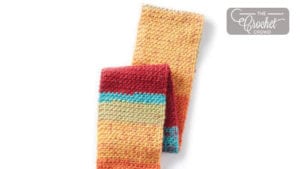
You could do straight forward single crochet to keep it simple or use a linen stitch. The Crochet Simple Texture Scarf is the linen stitch and easy to do.
If you are going to do a temperature blanket with the scarf pattern. Use the size hook you prefer but ensure your chain is EVEN NUMBER to match it. You can follow the tutorial if you need help but the scarf will work for a full-size blanket.
For New Crocheters
Be sure when chaining, chain an EVEN NUMBER. You can measure out your chain to match a sofa, person or bed. The bigger the chain, the longer it will take to make the project.
The hook and yarn in the tutorials below are suggestions but I would look above for the recommended hook size and use Red Heart Super Saver or equivalent.

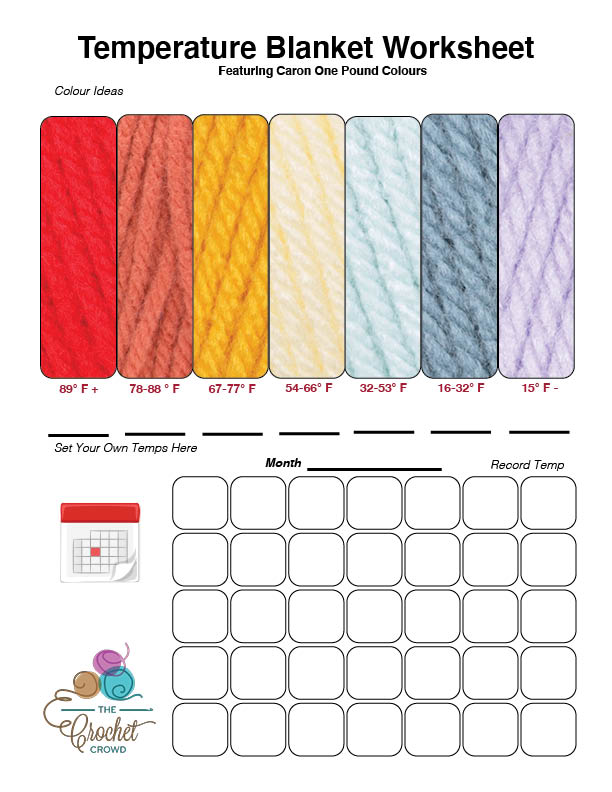
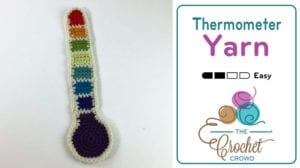

Mary Coykendall says
I made one for the year 2020 using the chevron pattern. To eliminate the great length, I split it in two...one blanket for Jan-June and another for July-Dec. They turned out perfect size to fit our full size bed.
Bettie Bryant says
I did the same. Mine is spring/summer and fall/winter.
Elizabeth says
Seriously? I have been crocheting since I was about 12 years old and I am 60 now and have never heard of this no offense here but I don’t think anybody really cares whether the colors of the Afghan reflect the current temperatures where are you live. And I can crochet much too fast for that idea. I can do a standard throw in less than a week.
And what would be next choosing crochet color based upon the face of your monthly “Cycle”? Can someone explain where this started and why I am just curious
Mikey says
It's neat but I really don't think many people actually follow through all year. I don't see a huge amount done by the end of the year. However, I think some of it is time but boredom can set in as well.
Amanda says
Elizabeth, temperature scarves/blankets/projects are one way that a climate scientist showed global warming over time. Joan Sheldon, a scientist who created one that spanned centuries, said she found that at science conferences people connected with and reacted quite differently to the textile than to a bar graph of the same data. (Fast Company has an article about it!)
Also, some people crochet as a process, not a product, so taking a year to work on a project bit by bit isn't a huge deal. Surely in your 48 years of crocheting, you've met people who do it for enjoyment and not just an end product. 🙂
And, actually, I once saw a piece of art at a museum that was a chart of a woman's cycle. This wasn't a piece of modern art either, but from the early 1800s if I remember correctly. It was a way to keep track before paper calendars were easily accessible! So yes, you could do that too.
J says
It was just meant to be a fun project.
Kathy Grile says
I've made several temperature afghans and always find a way to mix it up with the stitches and I don't just work the temperature. I also stitch the daily condition (sunny, rainy, snowy or cloudy). This year I'm working up the afghan with the millstone stitch and separating each day with black.